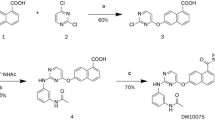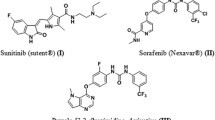Abstract
Vascular endothelial cell growth factor (VEGF) plays an important role in the processes of angiogenesis. Angiogenesis appears to be essential for the growth of solid tumors and their metastasis. VEGF plays a principal role in tumor angiogenesis. To identify a compound that inhibits the binding of VEGF to its receptor, we used a high-throughput screening method and found that oxydibenzoic acid derivatives inhibited VEGF binding to its receptors. Among the active compounds, 5-{3-[4-(octadecyloxy)phenyl]propionylamino}-2,4′-oxydibenzoic acid (VGA1102) was selected based on its potent binding inhibitory activity. VGA1102 inhibited [125I]VEGF binding to both of two VEGF receptor-transfected cell lines, NIH-Flt-1 and NIH-KDR/Flk-1, in a concentration-dependent manner, with IC50 values of 0.66±0.07 and 0.61±0.16 μM, respectively. VGA1102 (10 μM) exhibited inhibitory activity against VEGF-induced receptor autophosphorylation. VGA1102 also inhibited VEGF-induced growth of rat liver sinusoidal endothelial cells (IC50=0.89±0.16 μM) as well as VEGF-induced tube formation of HUVEC in vitro. VGA1102 reduced intradermal VEGF-induced vascular permeability in guinea pigs. Treatment with VGA1102 (50 mg/kg, i.p., days 0–20) significantly increased the lifespan of MM2-bearing mice with an increase in lifespan of >195.8%, and all such mice were long-term survivors on day 71. Furthermore, VGA1102 (50 mg/kg, i.p.) administered daily suppressed the growth of nude mice transplanted with LC-6 human non-small-cell lung cancer. These results suggest that VGA1102 inhibits VEGF function resulting in inhibition of tumor angiogenesis, which led to suppression of growth of human tumors transplanted into nude mice.







Similar content being viewed by others
Abbreviations
- BSA:
-
bovine serum albumin
- DMEM:
-
Dulbecco’s modified Eagle’s medium
- FBS:
-
fetal bovine serum
- Flt-1:
-
fms-like tyrosine kinase
- HUVEC:
-
human umbilical vein endothelial cells
- ILS:
-
increase in lifespan
- KDR/Flk-1:
-
kinase insert domain containing receptor/fetal liver kinase
- MEM:
-
minimum essential medium
- MST:
-
median survival time
- MTT:
-
3-(4,5-dimethylthiazol-2-yl)-2,5-diphenyltetrazolium bromide
- PBS:
-
phosphate-buffered saline
- VEGF:
-
vascular endothelial growth factor
References
Aviezer D, Cotton S., David M, Segev A, Khaselev N, Galili N, Gross Z, Yayon A (2000) Porphyrin analogues as novel antagonists of fibroblast growth factor and vascular endothelial growth factor receptor binding that inhibit endothelial cell proliferation, tumor progression, and metastasis. Cancer Res 60:2973
Bae D, Gho Y, Yoon W, Chae C (2000) Arginine-rich anti-vascular endothelial growth factor peptides inhibit tumor growth and metastasis by blocking angiogenesis. J Biol Chem 275:13588
Binetruy-Tournaire R, Demangel C, Malavaud B, Vassy R, Rouyre S, Kraemer M, Plouet J, Derbin C, Perret G, Mazie JC (2000) Identification of a peptide blocking vascular endothelial growth factor (VEGF)-mediated angiogenesis. EMBO J 19:1525
Ferrara N (1999) Molecular and biological properties of vascular endothelial growth factor. J Mol Med 77:527
Ferrara N, Davis-Smyth T (1997) The biology of vascular endothelial growth factor. Endocrinol Rev 18:4
Fidler IJ, Ellis LM (1994) The implications of angiogenesis for the biology and therapy of cancer metastasis. Cell 79:185
Folkman J (1995) Angiogenesis in cancer, vascular, rheumatoid and other disease. Nat Med 1:27
Fong TAT, Shawver LK, Sun L, Tang C, App H, Powell TJ, Kim YH, Schreck R, Wang X, Risau W, Ullrich A, Hirth KP, McMahon G (1999) SU5416 is a potent and selective inhibitor of the vascular endothelial growth factor receptor (Flk-1/KDR) that inhibits tyrosine kinase catalysis, tumor vascularization, and growth of multiple tumor types. Cancer Res 59:99
Kim KJ, Li B, Winer J, Armanini M, Gillett N, Phillips HS, Ferrara N (1993) Inhibition of vascular endothelial growth factor-induced angiogenesis suppresses tumour growth in vivo. Nature 362:841
Kondo S, Asano M, Suzuki H (1993) Significance of vascular endothelial growth factor/vascular permeability factor for solid tumor growth, and its inhibition by the antibody. Biochem Biophys Res Commun 194:1234
Laird AD, Vajkoczy P, Shawver LK, Thurnher A, Liang C, Mohammadi M, Schlessinger J, Ullrich A, Hubbard SR, Blake RA, Fong TAT, Strawn LM, Sun L, Tnag C, Hawtin R, Tang F, Shenoy N, Hirth KP, McMahon G, Cherrington JM (2000) SU6668 is a potent antiangiogenic and antitumor agent that induces regression of established tumors. Cancer Res 60:4152
Luo JC, Yamaguchi S, Shinkai A, Shitara K, Shibuya M (1998) Significant expression of vascular endothelial growth factor/vascular permeability factor in mouse ascites tumors. Cancer Res 58:2652
Luo JC, Toyoda M, Shibuya M (1998) Differential inhibition of fluid accumulation and tumor growth in two mouse ascites tumors by an antivascular endothelial growth factor/permeability factor neutralizing antibody. Cancer Res 58:2594
Nakaike S, Yamagishi T, Nanaumi K, Otomo S, Tsukagoshi S (1992) Cell-killing activity and kinetic analysis of a novel antitumor compound NC-190, a benzo[a]phenazine derivative. Jpn J Cancer Res 83:402
Prewett MHJ, Li Y, Santiago A, O’Connor W, King K, Overholser J, Hooper A, Pytowski B, Witte L, Bohlen P, Hicklin DJ (1999) Antivascular endothelial growth factor receptor (fetal liver kinase 1) monoclonal antibody inhibits tumor angiogenesis and growth of several mouse and human tumors. Cancer Res 59:5209
Ruckman J, Green LS, Beeson J, Waugh S, Gillette WL, Henninger DD, Claesson-Welsh L, Janic N (1998) 2′-Fluoropyrimidine RNA-based aptamers to the 165-amino acid form of vascular endothelial growth factor (VEGF165). Inhibition of receptor binding and VEGF-induced vascular permeability through interactions requiring the exon 7-encoded domain. J Biol Chem 273:20556
Sawano A, Takahashi T, Yamaguchi S, Aonuma M, Shibuya M (1996) Flt-1 but not KDR/Flk-1 tyrosine kinase is a receptor for placenta growth factor, which is related to vascular endothelial growth factor. Cell Growth Differ 7:213
Senger DR, Galli SJ, Dvorak AM, Perruzzi CA, Harvey VS, Dvorak HF (1983) Tumor cells secrete a vascular permeability factor that promotes accumulation of ascites fluid. Science 219:983
Shibuya M (1995) Role of VEGF-Flt receptor system in normal and tumor angiogenesis. Adv Cancer Res 67:281
Shibuya M, Ito N, Claesson-Welsh L (1999) Structure and function of vascular endothelial growth factor receptor-1 and -2. Curr Topics Microbiol Immunol 237:59
Tashiro T, Inaba M, Kobayashi T, Sakurai Y, Maruo K, Ohnishi Y, Ueyama Y, Nomura T (1989) Responsiveness of human lung cancer/nude mouse to antitumor agents in a model using clinically equivalent doses. Cancer Chemother Pharmacol 24:187
van Bruggen N, Thibodeaux H, Palmer JT, Lee WP, Fu L, Cairns B, Tumas D, Gerlai R, Williams SP, van Lookeren Campagne M, Ferrara N (1999) VEGF antagonism reduces edema formation and tissue damage after ischemia/reperfusion injury in the mouse brain. J Clin Invest 104:1613
Wedge SR, Ogilvie DJ, Dukes M, Kendrew J, Curwen JO, Hennequin LF, Thomas AP, Stokes ES, Curry B, Richmond GH, Wadsworth PF (2000) ZD4190: an orally active inhibitor of vascular endothelial growth factor signaling with broad-spectrum antitumor efficacy. Cancer Res 60:970
Wood JM, Bold G, Buchdunger E, Cozens R, Ferrari S, Frei J, Hoffman F, Mestan J, Mett H, O’Reilly T, Persohn E, Rosel J, Schnell C, Stover D, Theuer A, Towbin H, Wenger F, Woods-Cook K, Menrad A, Siemeister G, Schirner M, Thierauch KH, Schneider MR, Drevs J, Martiny-Baron G, Totzke F, Marme D (2000) PTK787/ZK222584, a novel and potent inhibitor of vascular endothelial growth factor receptor tyrosine kinases, impairs vascular endothelial growth factor-induced responses and tumor growth after oral administration. Cancer Res 60:2178
Xu L, Yoneda J, Herrera C, Wood J, Killion JJ, Fidler IJ (2000) Inhibition of malignant ascites and growth of human ovarian carcinoma by oral administration of a potent inhibitor of the vascular endothelial growth factor receptor tyrosine kinases. Int J Oncol 16:445
Yamagishi T, Nakaike S, Ikeda T, Ikeya H, Otomo S (1996) A novel antitumor compound, NC-190, induces topoisomerase II-dependent DNA cleavage and DNA fragmentation. Cancer Chemother Pharmacol 38:29
Yamane A, Seetharam L, Yamaguchi S, Goto N, Takahashi T, Neufeld G, Shibuya M (1994) A new communication system between hepatocytes and sinusoidal endothelial cells in liver through vascular endothelial growth factor and Flt tyrosine kinase receptor family (Flt-1 and KDR/Flk-1). Oncogene 9:2683
Yano S, Herbst RS, Shinohara H, Knighton B, Bucana CD, Killion JJ, Wood J, Fidler IJ (2000) Treatment for malignant pleural effusion of human lung adenocarcinoma by inhibition of vascular endothelial growth factor receptor tyrosine kinase phosphorylation. Clin Cancer Res 6:957
Author information
Authors and Affiliations
Corresponding author
Rights and permissions
About this article
Cite this article
Ueda, Y., Yamagishi, T., Samata, K. et al. A novel low molecular weight VEGF receptor-binding antagonist, VGA1102, inhibits the function of VEGF and in vivo tumor growth. Cancer Chemother Pharmacol 54, 16–24 (2004). https://doi.org/10.1007/s00280-004-0763-8
Received:
Accepted:
Published:
Issue Date:
DOI: https://doi.org/10.1007/s00280-004-0763-8




